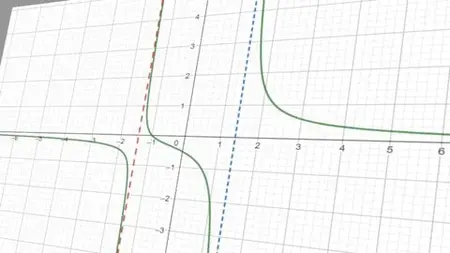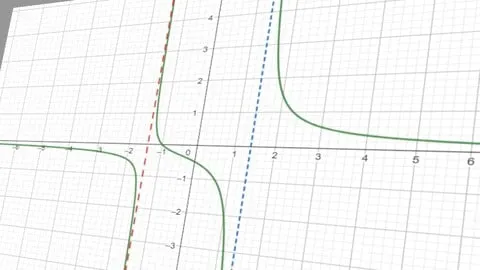Interactive Algebra Ii: Learn By Doing
Published 2/2025
MP4 | Video: h264, 1920x1080 | Audio: AAC, 44.1 KHz
Language: English | Size: 4.80 GB | Duration: 20h 17m
Published 2/2025
MP4 | Video: h264, 1920x1080 | Audio: AAC, 44.1 KHz
Language: English | Size: 4.80 GB | Duration: 20h 17m
An Engaged Approach To Teach You Algebra II
What you'll learn
Students will learn about functions and their domain.
Students will learn about inverse functions and composite functions and their domains.
Students will learn about exponential functions and logarithmic functions.
Students will learn how to graph polynomial and rational functions.
Requirements
Completion of an Algebra I course
Description
This is an Algebra II course structured on the OpenStax textbook College Algebra. Each section begins with an original activity designed to show you the concepts in a way that brings deeper understanding. Work the activity. And if you need help, watch the video where I walk through every question of the activity. A link to a full, traditional lecture is also available. Use this course to learn Algebra II for the first time or use this course as a tutoring tool to help you with the course you are already taking. Designed to mimic the engaged learning approach which I use in my college classrooms, you drive the learning, and I serve as the facilitator. I also created this course to be an alternative to traditional tutoring. Tutoring is fantastic, but it can be expensive and hard to find. Here, my activities are the exact material and concepts which I would share with you in a tutoring session to bring the concepts home. So, use the index of the textbook to find the topics you need, and search for the activity which you are working on in your traditional classroom. The choice is yours.Section topics discussed are:Equations and InequalitiesFunctionsLinear FunctionsPolynomial and Rational FunctionsExponential and Logarithmic FunctionsSystems of Equations and InequalitiesAnalytic GeometrySequences, Probability, and Counting Theory
Overview
Section 1: Introduction
Lecture 1 Introduction
Lecture 2 How to Use This Course as a Tutoring Tool
Section 2: Prerequisites
Lecture 3 1.1a: Classifying Numbers and the Order of Operations
Lecture 4 1.1b: Key Math Properties; Evaluating Expressions; Simplifying Expressions
Lecture 5 1.2a: Exponent Rules
Lecture 6 1.2b: Scientific Notation
Lecture 7 1.3a: Working with Roots
Lecture 8 1.3b: Rationalizing Denominators; Fractional Exponents
Lecture 9 1.4a: Adding, Subtracting and Multiplying Polynomials
Lecture 10 1.4b: Special Patterns when Multiplying Polynomials
Lecture 11 1.5a: Factoring Polynomials
Lecture 12 1.5b: Factoring the Sum or Difference of Cubes; Factoring Fractional Exponents
Lecture 13 1.6a: Simplifying Rational Expressions
Lecture 14 1.6b: Adding and Subtracting Rational Expressions
Section 3: Equations and Inequalities
Lecture 15 2.1a: Graphing by Plotting Points; x and y-intercepts
Lecture 16 2.1b: The Midpoint and Distance Formulas
Lecture 17 2.2a: Solving Equations
Lecture 18 2.2b: Slope of a Line; Standard Form of a Line
Lecture 19 2.2c: Parallel and Perpendicular Lines
Lecture 20 2.3a: Word Problems Involving Lines and D=rt
Lecture 21 2.3b: Word Problems Involving Perimeter and Area
Lecture 22 2.4a: Introduction to Complex Numbers
Lecture 23 2.4b: Adding/Subtracting and Multiplying Complex Numbers
Lecture 24 2.4c: Dividing Complex Numbers
Lecture 25 2.5a: Solving Quadratic Equations
Lecture 26 2.5b: The Quadratic Formula
Lecture 27 2.6a: Higher Order Roots and Equations with Rational Exponents
Lecture 28 2.6b: Solving absolute value, higher order, and rational equations
Lecture 29 2.7a: Compound Inequalities
Lecture 30 2.7b: Absolute Value Inequalities
Section 4: Functions
Lecture 31 3.1a: Introduction to Functions
Lecture 32 3.1b: One-to-One Functions
Lecture 33 3.2a: Domain of a Function
Lecture 34 3.2b: Graphs of the Toolkit Functions; Piecewise Functions
Lecture 35 3.3a: Average Rate of Change
Lecture 36 3.3b: Increasing and Decreasing; Extrema of a Function
Lecture 37 3.4a: Mathematical Operations on Functions; Composite Functions
Lecture 38 3.4b: Domain of a Composite Function
Lecture 39 3.5a: Vertical and Horizontal Transformations of Functions
Lecture 40 3.5b: Combining Multiple Transformations
Lecture 41 3.5c: Vertical and Horizontal Stretches/Compressions; Even/Odd Functions
Lecture 42 3.6: Absolute Value Functions
Lecture 43 3.7a: Inverse Functions
Lecture 44 3.7b: Finding an Inverse of a Function
Section 5: Linear Functions
Lecture 45 4.1a: Applying Lines as Functions
Lecture 46 4.1b: Understanding Lines as Transformations
Lecture 47 4.1c: Investigating Parallel or Perpendicular Lines as Functions
Lecture 48 4.2: Further Applications with Linear Functions
Lecture 49 4.3a: Introduction to Correlation and Scatterplots
Lecture 50 4.3b: Introduction to Linear Regression
Section 6: Polynomial and Rational Functions
Lecture 51 5.1a: The Vertex Form of a Quadratic Function
Lecture 52 5.1b: Intercepts of Quadratics; Max/Min of Quadratics
Lecture 53 5.1c: Applications involving Max/Min of a Quadratic
Lecture 54 5.2a: Introduction to Polynomial Functions
Lecture 55 5.2b: End Behavior of Polynomial Functions
Lecture 56 5.3a: Intercepts of Polynomial Functions; Multiplicity
Lecture 57 5.3b: Graphing Polynomial Functions
Lecture 58 5.4a: Dividing Polynomials Using Long Division
Lecture 59 5.4b: Dividing Polynomials Using Synthetic Division
Lecture 60 5.5a: The Remainder Theorem and the Factor Theorem
Lecture 61 5.5b: The Rational Zero Theorem
Lecture 62 5.5c: Descartes Rule of Signs
Lecture 63 5.6a: Asymptotes of Rational Functions
Lecture 64 5.6b: Graphing Rational Functions
Lecture 65 5.7a: Review of Inverse Functions
Lecture 66 5.7b: Restricting Functions
Lecture 67 5.7c: Finding the Inverse of a Formula
Lecture 68 5.8: Direct and Indirect Variation
Section 7: Exponential and Logarithmic Functions
Lecture 69 6.1a: Introduction to the Exponential Function
Lecture 70 6.1b: Compound and Continuous Interest
Lecture 71 6.2a: Transformations of the Exponential Function
Lecture 72 6.2b: Graphing Exponential Functions
Lecture 73 6.3: Introduction to Logarithms
Lecture 74 6.4a: Graphs of Logarithmic Functions
Lecture 75 6.4b: Graphing Transformations of Logarithms
Lecture 76 6.5a: Properties of Logarithms
Lecture 77 6.5b: Condensing Logarithms and the Change of Base Formula
Lecture 78 6.6a: Solving Equations Involving the Exponential Function
Lecture 79 6.6b: Solving Equations Involving Logarithms
Section 8: Systems of Equations and Inequalities
Lecture 80 7.1a: Solving Systems of Linear Equations by Graphing
Lecture 81 7.1b: Solving Systems of Linear Equations by Substitution
Lecture 82 7.1c: Solving Systems of Linear Equations by Elimination
Lecture 83 7.2: Solving Three-Dimensional Systems of Equations
Lecture 84 7.3a: Solving Systems of Non-Linear Equations
Lecture 85 7.3b: Solving Non-Linear Systems of Inequalities
Lecture 86 7.4a: Decomposing Fractions
Lecture 87 7.4b: Decomposing Fractions which Include Quadratics
Lecture 88 7.5a: Introduction to Matrices
Lecture 89 7.5b: Multiplying Matrices
Lecture 90 7.6a: Solving Systems of Linear Equations with Augmented Matrices
Lecture 91 7.6b: Solving Larger Systems of Equations with Matrices
Lecture 92 7.7a: Inverse Matrices
Lecture 93 7.7b: Solving Systems of Equations with Inverse Matrices
Lecture 94 7.8a: Determinant of a Matrix; Cramer's Rule
Lecture 95 7.8b: Properties of Determinants
Section 9: Analytic Geometry
Lecture 96 8.1a: Understanding the Equation for the Standard Form of an Ellipse
Lecture 97 8.1b: Graphing an Ellipse
Lecture 98 8.1c: Rewriting the Equation for an Ellipse in Standard Form
Lecture 99 8.2a: Understanding the Equation for the Standard Form of a Hyperbola
Lecture 100 8.2b: Graphing Hyperbolas
Lecture 101 8.2c: Write an Equation for a Hyperbola in Standard Form
Lecture 102 8.3a: Understanding the Equation for the Standard Form of a Parabola
Lecture 103 8.3b: Graphing Parabolas
Lecture 104 8.3c: Write an Equation for a Parabola in Standard Form
Section 10: Sequences, Probability and Counting Theory
Lecture 105 9.1a: Explicit Formulas for Sequences
Lecture 106 9.1b: Recursive Formulas for Sequences
Lecture 107 9.2a: Introduction to Arithmetic Sequences
Lecture 108 9.2b: Writing Explicit and Recursive Formulas for Arithmetic Sequences
Lecture 109 9.3a: Introduction to Geometric Sequences
Lecture 110 9.3b: Writing Explicit and Recursive Formulas for Geometric Sequences
Lecture 111 9.4a: Summations
Lecture 112 9.4b: Infinite Geometric Sequences
Lecture 113 9.5: Counting Principle; Combinations and Permutations
Lecture 114 9.6: The Binomial Theorem
Lecture 115 9.7: Basic Probability
High School or College Learners needing help with Algebra II or College Algebra



